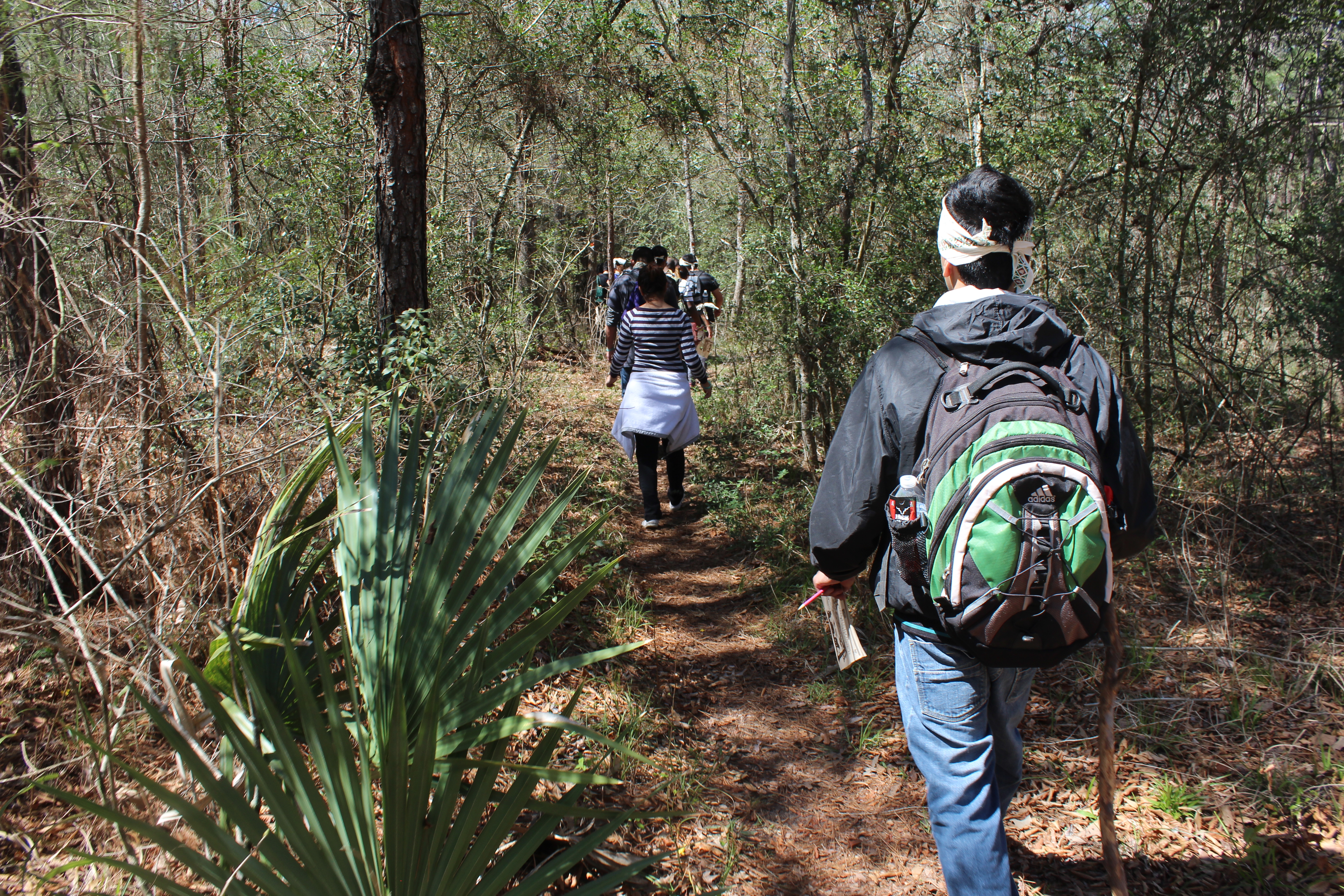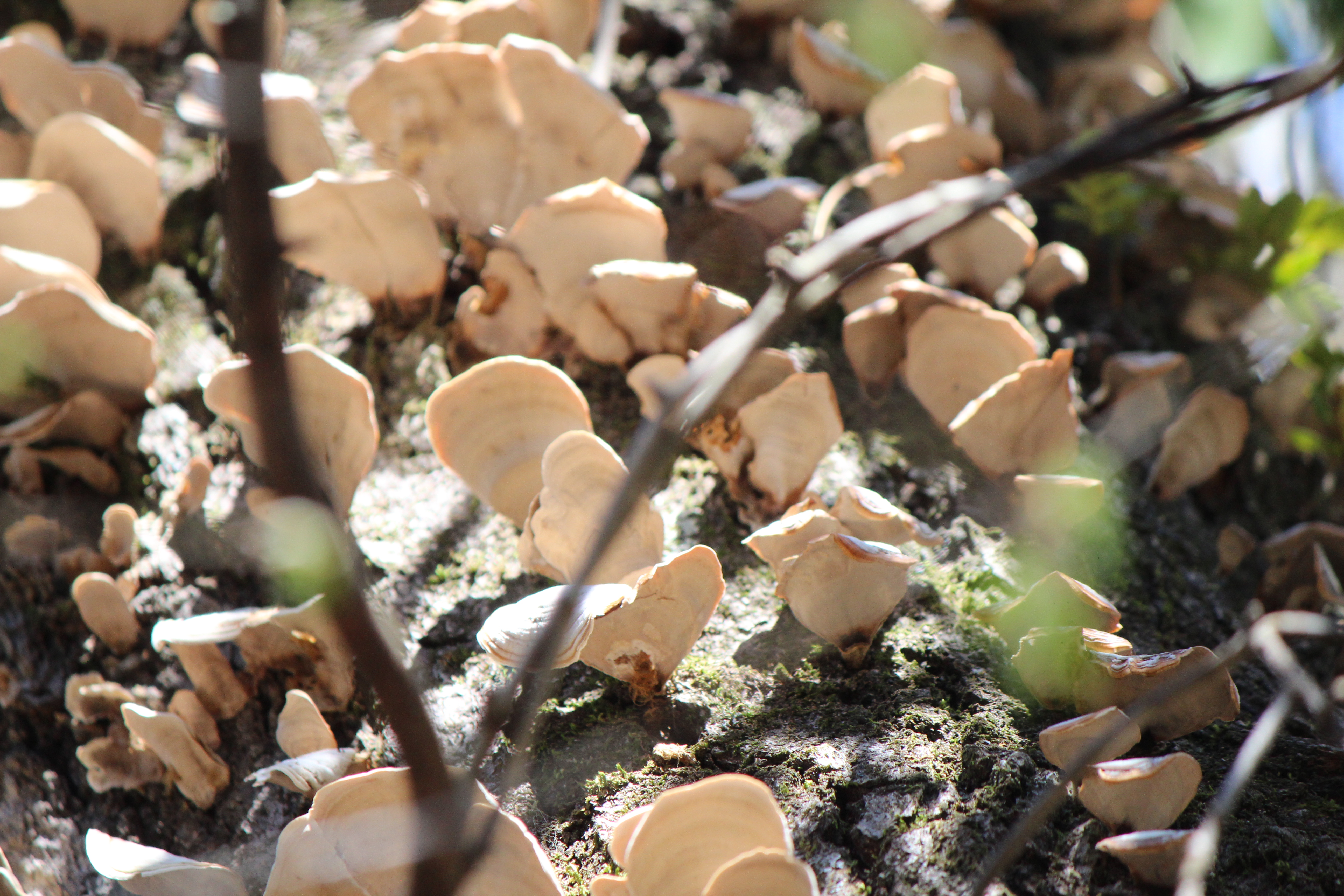 |
| On the Little Lake Creek trail at Little Lake Creek Wilderness. |
 |
| Little Lake Creek Wilderness features the increasingly rarefied gem of southern eastern U.S. forests: the bottomland hard woods. |
 |
| Valeria Berron, Gaby Bravo and the indefatigable Woodsy Owl enjoy Little Lake Creek Wilderness' spring offering: an aromatic Yellow Jesamine. |
Some Wilderness survival tips from Kenneth Kramm
- You can kill bacteria and viruses in water by setting a clear plastic water bottle in sunlight for 8 hours. The ultraviolet radiation will kill most of the biological contaminants in the water, if the water is clear enough for light to penetrate. If you can place the water bottle on top of a newspaper and read the headlines through the water, its safe to use this technique.
- You can repel mosquitoes by burning wax myrtle leaves.
- You can make a caffeinated tea with yaupon leaves. Simply dry them or cook them on a pan. Do not boil the berries, and make sure you are using real yaupon (Ilex vomitoria) leaves.
Ken also talked about how fragile the ecosystem can be, talking about how there are even problems with invasive earthworms in northern U.S. But nature can also be an inspiration, Kramm told us; NASA scientists took resurrection fern (Pleopeltis polypodioides) into space to study its marvelous ability to come back to life after being up to 90% dessicated. Engineers are hoping to understand how the fern goes from shriveled back to full size in a matter of hours to discover novel ways to build buildings and machines.
 |
| This is resurrection fern, as found growing on a hardwood branch on Little Lake Creek Wilderness in the Sam Houston National Forest. |
Service Learning
The Forest Service has graciously allowed us to use the Stubblefield Lake Recreation Area for free, so after we got back to camp headquarters, the students returned the favor by picking up trash around the banks of that lake for free. They also picked up trash around the bridge going into the campground, helping to keep |
| Picking up trash around Stubblefield Lake Recreation Area, to pay back the Forest Service for the free stay. |
The students made their own delicious foil dinners, which are deceptively simple to make.
- Build a good fire and produce a lot of hot coals. Use a shovel to break them up.
- Spray a large sheet of aluminum foil with cooking spray.
- Place chicken or beef on the aluminum foil. Add a liberal amount of cream of mushroom or cream of chicken soup, no more than a 1/4 cup of rice, 1 cup of frozen vegetables, and 1/4 cup of water.
- Wrap up the aluminum foil well, then place the foil packet on top of the coals. Put more coals on top.
- Cook from 20-30 minutes.
- Enjoy!
When the moon rose over the campground and the smore's were done, the campers ventured onto the Lone Star Hiking Trail for a night time stroll, where the campers learned to listen closely to the sound of the night. Everyone made it back to camp safely, and in awe of the nocturnal stillness.
A high school, and has been acquainted with going out into the outdoors before. But this trip was his first into a federally designated Wilderness.
Chris says that nature can offer him something that life in urban Houston cannot easily provide: tranquility. "I can relax and play a little in the forest without getting discouraged." he says "It's a calm place to think."
He also enjoys using nature for exercise. As we were heading back to the parking lot from our informal camp site in Little Lake Wilderness, Chris says he and a few friends took the opportunity to have a run through the forest. With as many dips and curves as there were, it was a good workout.
He said he would definitely recommend this adventure to a friend, and would tell her/him "Go out to the wild and experience something they haven't done before."
Tomorrow we leave Stubblefield and continue our adventures!
An interview with camper Chris Williams
Chris is a student from SFChris says that nature can offer him something that life in urban Houston cannot easily provide: tranquility. "I can relax and play a little in the forest without getting discouraged." he says "It's a calm place to think."
He also enjoys using nature for exercise. As we were heading back to the parking lot from our informal camp site in Little Lake Wilderness, Chris says he and a few friends took the opportunity to have a run through the forest. With as many dips and curves as there were, it was a good workout.
He said he would definitely recommend this adventure to a friend, and would tell her/him "Go out to the wild and experience something they haven't done before."
Tomorrow we leave Stubblefield and continue our adventures!

No comments:
Post a Comment